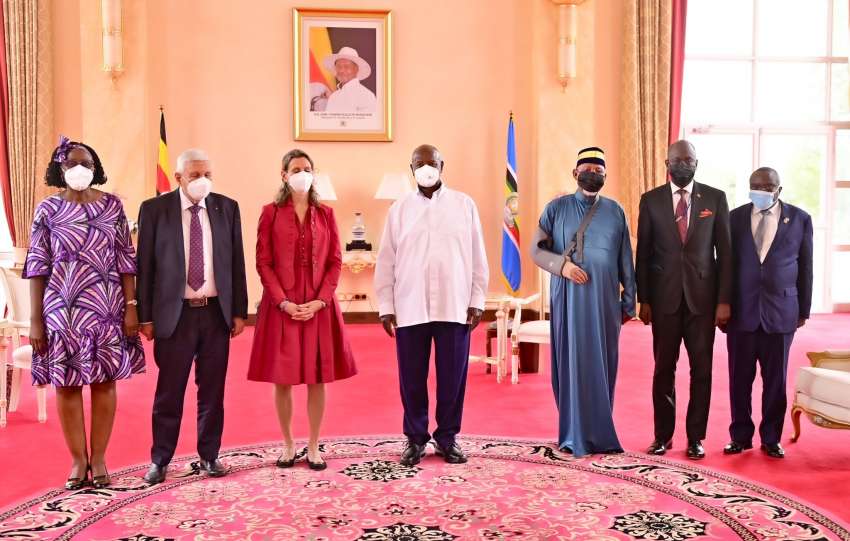Rooted deep into centuries of history and embedded in the Bugisu cultural fabric, Imbalu circumcision is a celebration of bravery, resilience, and unity that continues to be upheld with great pride and enthusiasm.
This history of Imbalu is by far traced back to the Bagisu, who are a Bantu ethnic group residing majorly in the mountain ranges of Eastern Uganda and in the districts of Sironko, Bududa, Manafwa, Budadiri, Bulambuli, Lwakhakha, Mbale, Namisindwa, Bubulo, and Bumbobi. Imbalu circumcision holds strong roots in their ancestral customs, dating back to pre-colonial times. Legend has it that the practice was introduced by a great-grandfather who migrated from the neighbouring Bukusu tribe in Kenya.
The Bagisu in Eastern Uganda numbered 1,646,904 in the Fifth Post-Independence National Population Census conducted in 2014.
Every two years, in the months of August and December, a circumcision ceremony is performed, beginning with a formal opening ceremony at the Mutoto Cultural Ground. This event draws visitors from all over the country, the region, and the continent and the world to see the bravery of young boys as they undergo the ritual to become men as candidates are typically between the ages of 16 and 20, who go through weeks of rigorous training before this important ceremony. The preparation includes teachings on cultural values, ethics, bravery, and responsibilities as men in the community.
On the day of the ceremony, candidates congregate in a central location where the festivities will take place, dressed in traditional outfit and ornaments. Traditional music, dances, and prayers are performed before the procedure to ask the gods and ancestors for their blessings on a successful circumcision.
Additionally, before the actual circumcision day, candidates, family members, friends, and relatives spend days running or walking candidates through nearby villages while playing traditional drums called “Kadodi” in the Bugisu local dialect. They hop from village to village while drinking local brew known as ”khamalule” and dancing all the way. The circumcision itself is then carried out by an expert and experienced traditional surgeon known as “umushebhi.” The surgeon carefully and skillfully peels off the foreskin of the candidates using a special knife that was made locally from bamboo and sharpened. In spite of their distress, the young men are obligated to remain brave by displaying no signs of fear or grief during the circumcision session.
After the circumcision, the initiates begin a recovery and solitude period that lasts for about 3–4 weeks for young people and much longer for adults. They live in solitude in traditional huts built for this purpose, where they are well cared for by skilled men and elders, throughout this time. This period allows them to bond, share experiences, and receive valuable life lessons, strengthening their sense of unity and brotherhood.
Significance of Imbalu ritual
The Imbalu circumcision is extremely important to the Bugisu people and to the culture of Uganda as a whole. It helps to transmit cultural heritage, traditions, and inherited knowledge to the next generation. The rite emphasizes the virtues of tenacity, fortitude, and persistence in the face of difficulties—characteristics highly prized in Bugisu society.
Additionally, Imbalu circumcision promotes a strong sense of belonging and community. The ritual strengthens the idea of a common identity and purpose among the Bugisu people, regardless of their social status or ethnicity. Additionally, it promotes gender norms by putting an emphasis on the duties and standards of manhood, such as supporting the family and developing the community.
The Imbalu circumcision, which embodies the cultural legacy and identity of the community, is a symbol of the fortitude and resiliency of the Bugisu people. This traditional ceremony serves as a potent reminder of the value of maintaining cultural traditions and their significant impact on the formation of personal and societal identities. The Bugisu people secure their safety by maintaining and celebrating Imbalu circumcision.
About Guide2Uganda
Guide2Uganda (www.guide2uganda.ug) is the most comprehensive source of travel information about Uganda on the web, with more content on its cities and towns, accommodations, attractions, events, museums, and galleries than any other online guide currently available for Uganda, as well as being a dynamic travel news and events driven site with new content added on a daily basis.
We are one of Uganda’s most powerful online media organizations, according to the WeFollow & Peer Index, which assesses online influence. Jumia Travel Uganda also awarded Guide2Uganda the “Best Destination Website in Uganda” at the 2018 Africa Travel Awards.
Share your travel stories & photos with the world via email: info@guide2uganda.ug



